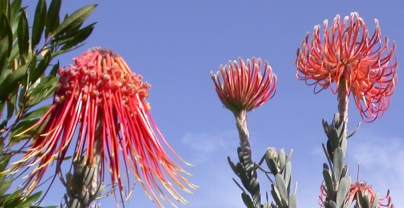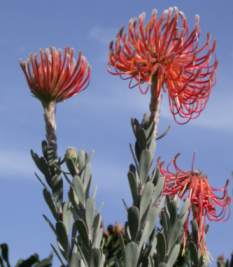Leucospermum reflexum
Leucospermum reflexum H.Buek ex Meisn.
Family: Proteaceae
Common names: var. reflexum : rocket pincushion, sky-rocket pincushion (Eng. ); perdekop (Afr.). var. luteum : yellow rocket pincushion (Eng.); geel perdekop (Afr.)
SA Tree No: 85.2
Introduction
A fireworks display in your garden during the day time is quite possible if you plant the magnificent rocket pincushions! These lovely, tall, upright pincushion plants with bright, deep orange to crimson or clear yellow flower heads atop the silvery-grey columns of densely leaved branches are real show-stoppers.

Description
Description
Leucospermum reflexum is a rounded, silvery grey-leaved shrub up to 4 m tall with either yellow (var. lutea) or deep orange to crimson (var. reflexum) flower heads which flower from spring to midsummer in the southern hemisphere (August to December). The more or less elliptic, simple leaves are covered with dense grey hairs. They are about 20-55 x 5-13 mm, with 2-3 glandular teeth at the tip. The rounded flower heads occur at the ends of the branches and are between 80-100 mm across.

Each flower is tube-like and made up of velvety floral parts called the perianth segments on which the anthers are placed. These surround the long style which escapes from the tube to form the 'pin' and the perianths then curl away from it. Young flowers are curved to start with, and then bend back toward the stem as they mature. The common name of rocket pincushion is very apt because these downward bent styles look like the fiery tail of a rocket trailing behind it. For the same reason, the Afrikaans name perdekop is a good one as the mature flower head looks like a horse's head with its mane blowing back in the wind.
The seeds ripen about 1-2 months after flowering and are then released. L. reflexum has a medium growth rate and usually flowers in its third year. Plants have been known to grow for about 20 years before becoming senescent, but are usually far less long-lived than this.
Conservation Status
Status
Leucospermum reflexum as a whole is recorded as having a threatened status of NT (near threatened) at present.
Distribution and habitat
Distribution description
Although the general area in the Cederberg, from Wuppertal to Pakhuis, where the plants occur, tends to be arid, these plants are found on sandstone soils near water sources such as streams. The plants usually occur in groups of a few hundred at altitudes ranging between 1000-2000 m. The yellow variety, L. reflexum var. luteum, comes from the Heuningvlei area in the Cederberg.
Derivation of name and historical aspects
History
The name is derived from the Greek words leukos= white and sperma = seed. The specific names are derived from the Latin words reflexus = bent downwards/bent back on themselves and luteus= yellow.
A German plant collector, Carl Friedrich Drège, first collected the common orange to crimson colour form of the species in 1830. It has since become a very popular garden and cut-flower plant.
It was only on the fourth attempt, in 1973, to find the yellow-flowered form after first hearing about it in 1970, that a tiny colony of Leucospermum reflexum var. luteum was discovered by John Winter, Curator of Kirstenbosch, together with other Kirstenbosch horticulturists and Dr John Rourke of the Compton Herbarium. They harvested some of the seed from these plants and got 13 seedlings to grow. From these they selected the best coloured plants for mother stock and the cuttings have produced the plants in cultivation today.

There are 48 species in the genus Leucospermum, most of which occur in the south-western and southern areas of the Western Cape Province. Some species are found in the Eastern Cape and others as far north as KwaZulu-Natal and Zimbabwe. Quite a number of species are popular in the cut-flower trade and as garden subjects. L. cordifolium is probably the most noteworthy of these. Several varieties of suitable Leucospermum species have been selected and a number of very attractive hybrids have been developed for both garden and vase.
Ecology
Ecology
The flowers are very popular with sugarbirds and sunbirds amongst other nectar-feeding birds who act as the pollinators. The branches are ideal perches while the birds feed, although the flowers are sturdy enough to cope also.
The nut-like seeds which develop after successful pollination are covered by a thin membrane and a small protuberance at the base called an elaiosome. The elaisome is rich in protein and is very attractive to many of our indigenous fynbos ants who collect the seeds and take them into their nests where the elaiosome is eaten. The seeds then lie protected in the nest and will usually germinate after a fire has swept through the area. Fire removes the plant cover around the nests, allowing the soil to be exposed to greater heat during the day and cooling at night, providing the fluctuating temperatures which are a trigger for seed germination. The chemicals in the smoke are also thought to help break seed dormancy and the fact that the young seedlings do not have to compete with other plants while they are young, encourages optimal growth. Ash from the fires provide easily accessible nutrients for the young plants.
Uses
Use
These plants are valuable in the garden as really colourful attractive feature plants or background plants to shorter material. The grey foliage will help highlight any other plant grown near them.
They are excellent cut-flowers, lasting well in the vase, with both their bright flower heads and grey foliage adding to the impact of an arrangement.
Their value for attracting nectar-feeding birds, especially sugarbirds, is great, and for this reason alone deserve a space in any garden with suitable growing conditions.

Growing Leucospermum reflexum
Grow
These plants come from the winter-rainfall region where temperatures can soar to well over 30°C in summer and drop below zero in winter, so they can be grown in most areas as long as the soil is well-drained and on the acid side, and they receive water during the winter months. They can tolerate a fair bit of cold and can even tolerate some frost. They will not, however, grow in areas which are hot and humid, as they are very prone to fungal problems under these conditions.
Seeds should be sown in autumn in a well-aerated and well-drained mixture and germinate best when there are alternating temperatures of around 4°C to10°C at night and 15°C to 20°C during the day. Soak the seeds in a 1% solution of hydrogen peroxide for 24 hours and then remove the softened outer membrane before sowing. A dusting of fungicide will be helpful to prevent disease problems. Cover the seed lightly with the soil mixture and place in a sunny, well-ventilated position. They can be pricked out into bags containing a sandy well-drained mixture in spring, once they have their first set of true leaves.
Cuttings can be taken in late summer or autumn and should be terminal or lateral shoots which should be growing in an erect position on the bush. Cuttings should be about 200-250 mm long, dipped in a growth hormone powder or solution and placed into a coarse, well-drained rooting medium in a mist bed with a bottom heat of 22°C-25°C. Good air movement is important to prevent fungal diseases. Rooting may take between 8 and 16 weeks and the plants should then be transplanted into bags, also containing a well-drained, sandy soil mixture and hardened off under 50% shadecloth for about a month before exposing them to full sunlight to further harden off.
When planted into the garden, the site should be sunny and well-drained and the plants should be well-mulched and watered regularly until established. A slow-release nitrogenous fertilizer which is low in phosphates but containing trace elements of Fe, Mg, Zn, Mn, and Cu is advantageous.
Fungal infections can be a problem when temperatures rise above 18°C and the relative humidity is above 75%. These conditions are probably the severest limiting factor as to where L. reflexum will grow well. Good air circulation is the best preventitive measure for fungal problems, but it may also be necessary, depending on weather conditions, to use a foliar fungicide as a preventative measure rather than as a curative one. Insect pests can be controlled with either a systemic or full cover spray developed for the particular pest.
Pruning is not necessary unless the bush needs to be shaped as this plant normally deadheads itself and the new branches then grow up from the position below the old flower head. If cutting for the vase, then it is advisable to make the cut into an area where there are still leaves and this will encourage branching. Cuts where there are no leaves will simply cause die-back of the remaining portion of the branch.
References
- Brown, N., Kotze, D. & Botha, P. 1998. Grow proteas. Kirstenbosch Gardening Series. National Botanical Institute, Cape Town.
- Brown, N. & Duncan, G. 2006. Grow fynbos plants. Kirstenbosch Gardening Series. South African National Biodiversity Institute, Cape Town.
- Eliovson, S. 1965. Proteas for pleasure. How to grow and identify them. Howard Timmins, Cape Town.
- Germishuizen, G., Meyer, N.L., Steenkamp, Y. & Keith, M. (eds). 2006. A checklist of South African plants. Southern African Botanical Diversity Network Report No. 41. SABONET, Pretoria.
- Kesting, D. (compiler). 2001. Wild flowers of the Cape Peninsula. Botanical names: origin and meaning. Flora Documentation Project, Friends of the Silvermine Nature Area, St James.
- Leistner, O.A. (ed.). 2000. Seed plants of southern Africa : families and genera. Strelitzia 10. National Botanical Institute, Pretoria.
- Matthews, L. 1993. The protea growers handbook including leucadendrons, banksias and grevilleas. Bok Books International, Trade Winds Press, Durban.
- Powrie, F. (compiler). 1988. Grow South African plants. Kirstenbosch Gardening Series. National Botanical Institute.
- Rebelo, T. 1995. Sasol proteas: a field guide to the proteas of southern Africa. Fernwood Press, Vlaeberg, Cape Town.
- Smith, C.A. 1966. Common names of South African plants. Memoirs of the Botanical Survey of South Africa No. 35.
- Winter, J.H.S. 1981. A new introduction into horticulture- Leucospermum reflexum Buek ex Meisn. var. luteum Rourke. Veld & Flora 67: 21-22
Credits
Jane Forrester
Harold Porter National Botanical Garden
July 2007
Plant Attributes:
Plant Type: Shrub, Tree
SA Distribution: Eastern Cape, Northern Cape, Western Cape
Soil type: Sandy
Flowering season: Spring, Early Summer
PH: Acid
Flower colour: Red, Yellow
Aspect: Full Sun
Gardening skill: Average
Special Features:
Horticultural zones








Rate this article
Article well written and informative
Rate this plant
Is this an interesting plant?
Login to add your Comment
Back to topNot registered yet? Click here to register.